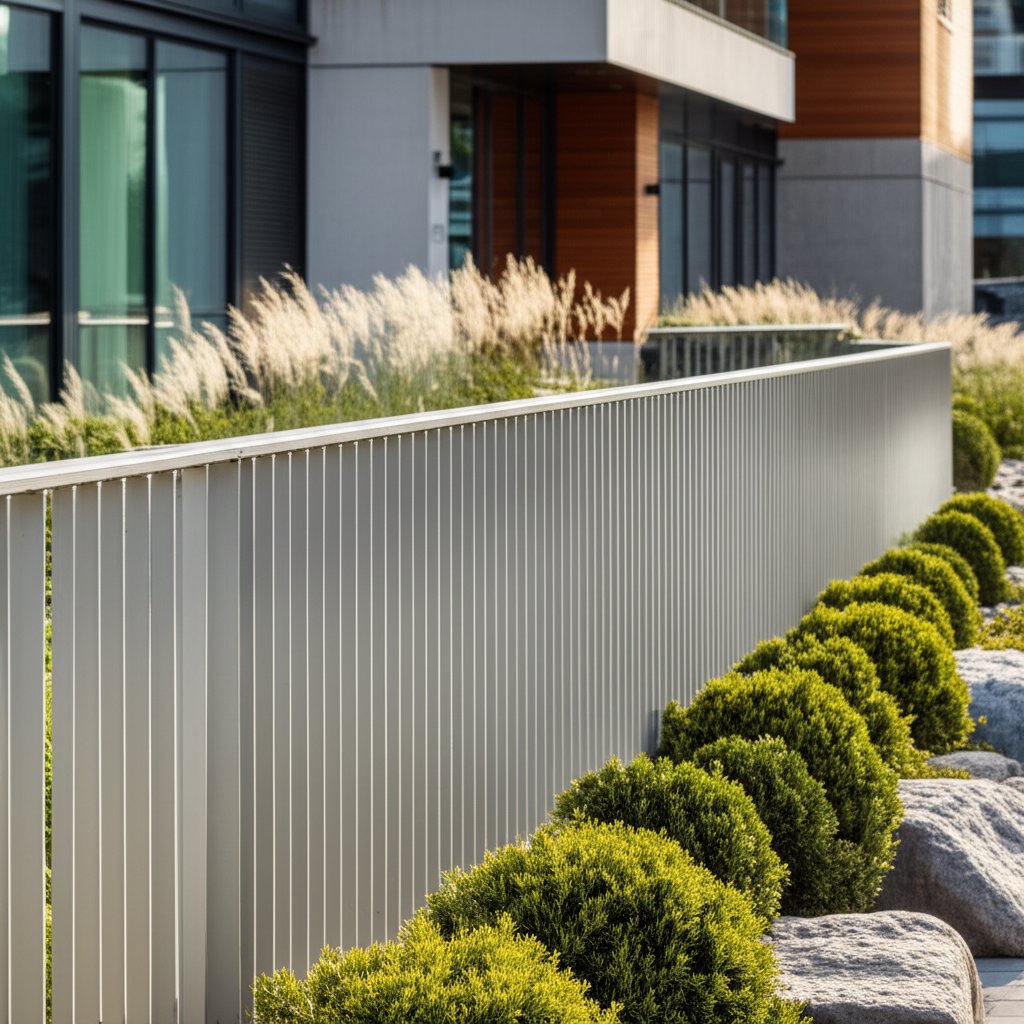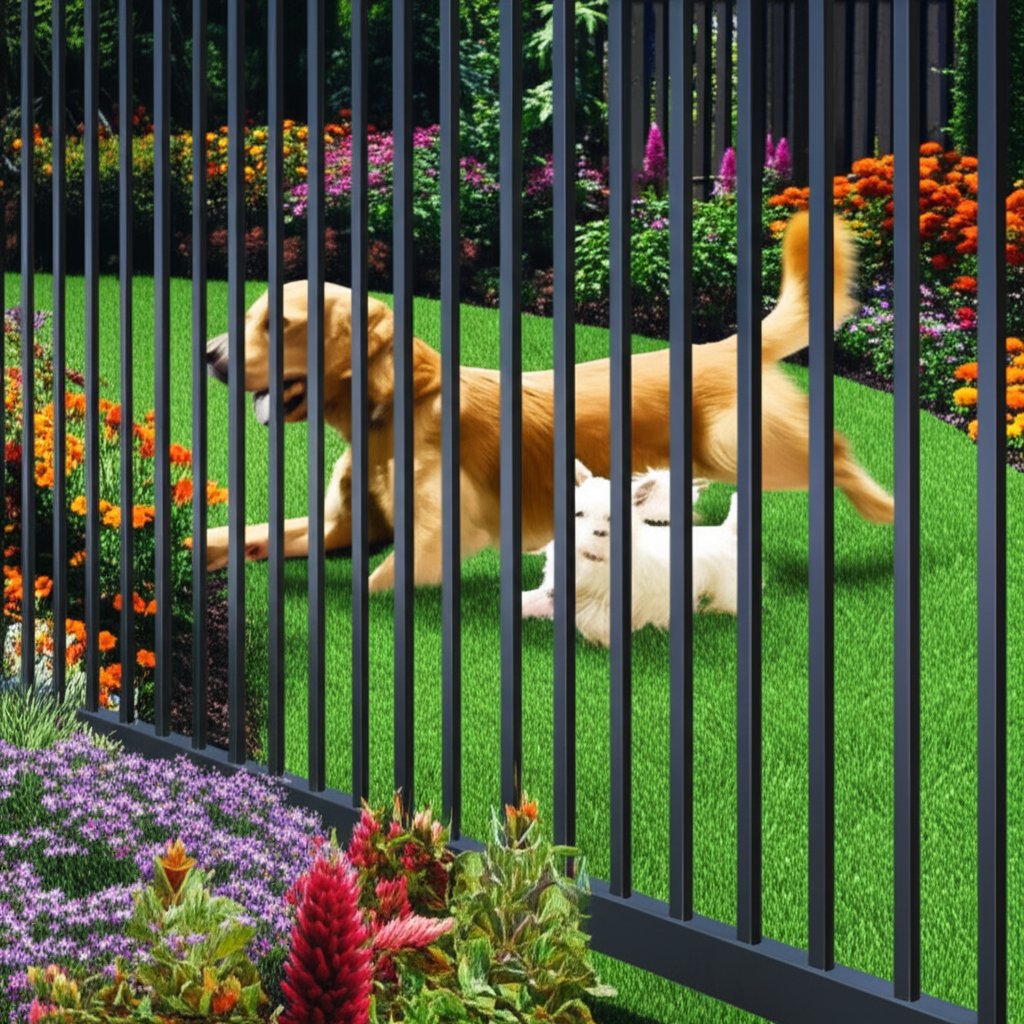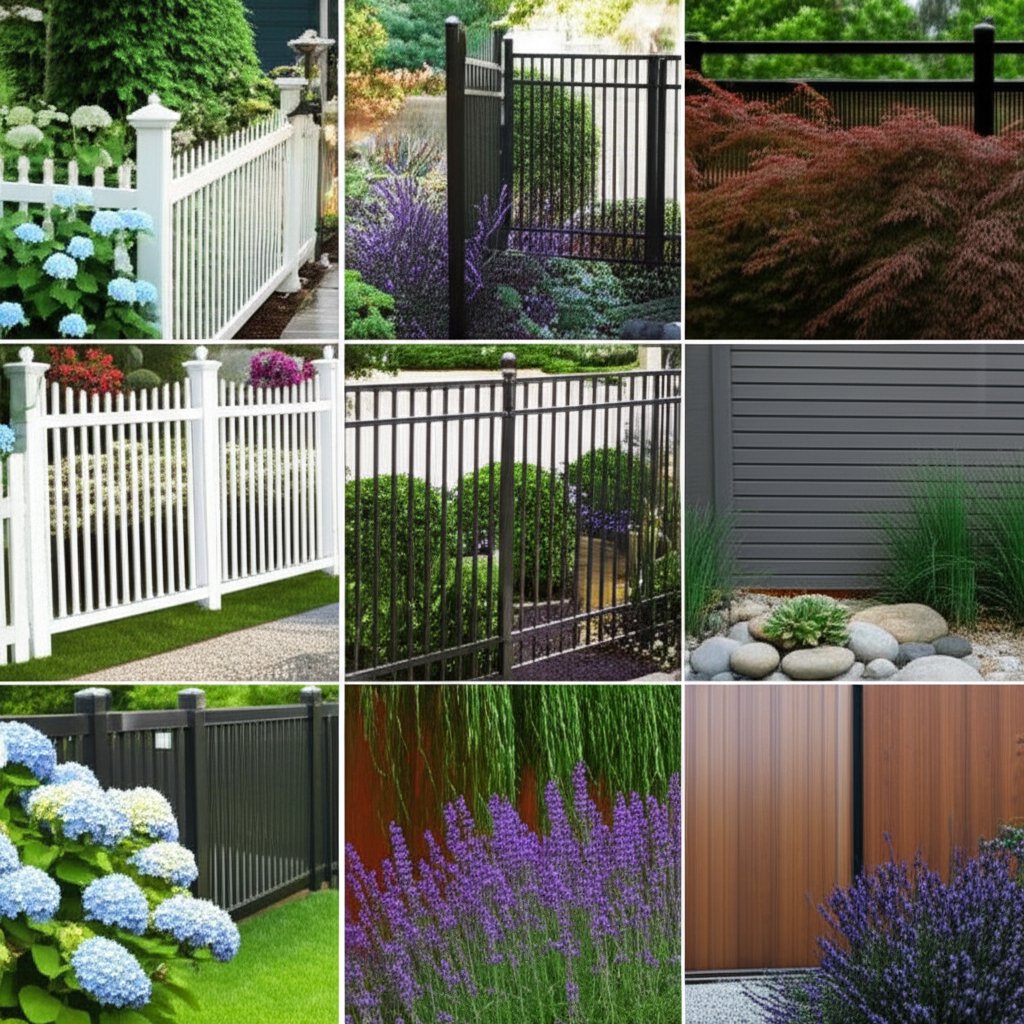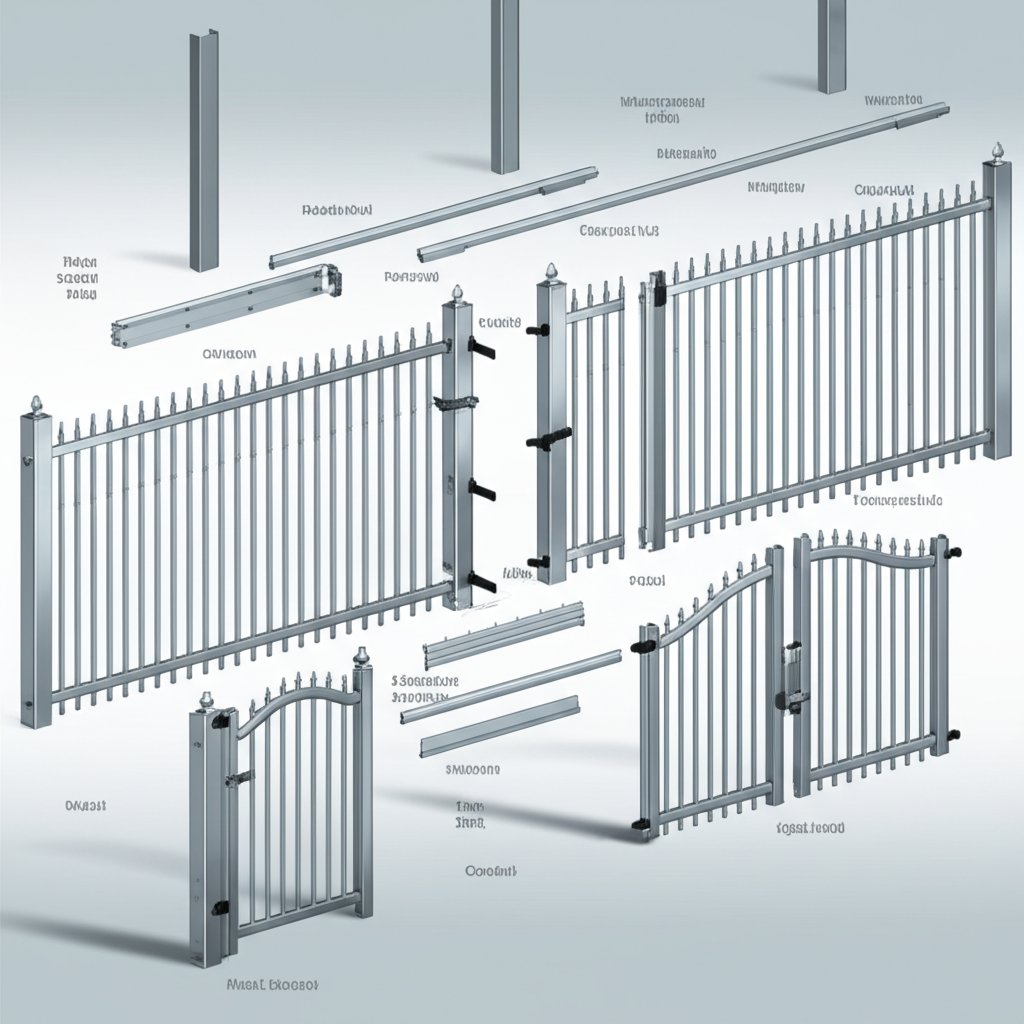
When you picture the ideal fence for your property, what comes to mind? Maybe you want something that looks stylish, lasts for years, and doesn’t eat up your weekends with constant upkeep. If so, you’re not alone—property owners in 2025 are increasingly turning to aluminum fencing as the go-to solution for both residential and commercial spaces.
Aluminum fences offer a unique combination of strength, elegance, and virtually zero maintenance, making them a top choice for property owners in 2025.
So, what sets an aluminum fence apart from the rest? At its core, this type of fencing is made from high-grade aluminum—a metal prized for its light weight, corrosion resistance, and adaptability. Unlike traditional wood, which can warp or rot, or wrought iron, which may rust and require frequent painting, aluminum stands strong against the elements. This makes it an outstanding option for anyone who wants a fence that looks as good in year ten as it did on day one.
Why has aluminum fencing become so popular? For starters, its clean lines and customizable designs fit seamlessly with both modern and classic architecture. Whether you’re enclosing a backyard, securing a business, or defining a pool area, you’ll notice that aluminum fencing adapts effortlessly to your needs. Plus, with the growing demand for sustainable building materials, aluminum’s 100% recyclability makes it a smart, eco-friendly choice.
Imagine installing a fence that doesn’t require scraping, repainting, or replacing after every harsh winter or humid summer. That’s the reality with today’s aluminum fence options. And with major suppliers offering a wide range of colors, finishes, and accessories, your fence can be as unique as your property.
Over the next sections, we’ll dive into each of these topics—so you can make an informed decision and avoid the #1 mistake many buyers make with alluminum fence or aluminun fence purchases. Ready to discover why aluminum fencing is the future of metal fencing? Let’s get started.

When you’re weighing your options for a new fence, it’s easy to get lost in the details. Is it really worth paying more upfront? Will it stand up to your climate, your pets, or the test of time? Let’s break down exactly why choosing an aluminum fence is a decision you—and your property—will appreciate for years to come.
Imagine living near the coast, where salty air and humidity cause wood to rot and metal to rust. With an aluminum fence, these worries fade away. Aluminum’s natural rust-proof properties make it a top performer in harsh environments, whether you’re in a rainy region, a snowy climate, or anywhere in between. Unlike wood, which can splinter, warp, or succumb to pests, aluminum stands strong, season after season. Even if you’re fencing in dogs or creating a small dog fence for your backyard, you’ll notice that aluminum won’t break down from pet activity or weather extremes.
Think about the time and money you spend on fence maintenance. With wood, there’s painting, staining, sealing, and fixing warped boards. But with aluminum fencing, upkeep is practically nonexistent. A quick rinse with the hose is often all it takes to keep your black metal fence or metal dog fence looking sharp. No annual treatments, no pest control, and no worrying about rot or decay. This low-maintenance nature means you can spend more time enjoying your yard—and less time working on it.
Are you worried that a metal fence will look too industrial? Aluminum fencing is anything but bland. With a wide variety of styles—from classic spear tops to sleek, modern lines—you can match your fence to your home’s character. Want the timeless look of a black metal fence, or need a puppy fence that doesn’t compromise curb appeal? Aluminum delivers. Plus, its sturdy pickets provide a secure boundary for children and pets. Whether you’re creating a safe play area or fencing for dogs of all sizes, you’ll find that aluminum offers both peace of mind and visual appeal.
In short, the core benefits of aluminum fencing boil down to three things: lasting durability, effortless maintenance, and flexible style options. Now that you understand why so many choose this material, let’s explore the different styles available to fit your unique needs and taste.

Ever wondered how to choose the perfect fence style to match your home’s personality or your business’s curb appeal? With aluminum fencing, the options are as diverse as your needs. Whether you’re aiming for timeless elegance, modern minimalism, or unmatched privacy, there’s a style that fits your vision—and your property’s requirements.
If you’re drawn to traditional charm, classic picket and ornamental aluminum fence designs are a natural choice. Imagine the crisp, clean lines of a picket fence—now picture it in durable, rust-resistant aluminum. These fences mimic the nostalgic look of wood but without the headaches of rot or termites. Add decorative finials or post caps, and you’ve got a fence that enhances curb appeal while keeping children and pets safe. Ornamental options often feature spear tops or intricate scrollwork, making them ideal for homes with historical or transitional architecture.
Prefer a sleek, contemporary vibe? The modern horizontal aluminum fence is gaining traction in today’s design-forward neighborhoods. These fences feature horizontal slats that deliver a minimalist, streamlined profile—ideal for modern homes or commercial spaces where clean lines and open sightlines matter. Horizontal slats can be spaced for partial visibility or tightly arranged for greater seclusion, making this style flexible for a variety of uses.
Need to turn your backyard into a private retreat? Solid and semi-private metal privacy fence panels are designed to shield your space from neighbors and street views. These fences are typically six feet tall or more, constructed with tightly fitted panels for maximum coverage. Some styles include decorative lattice tops for a touch of openness without sacrificing privacy. If security and solitude are your priorities, a black privacy fence or similar style can deliver both—while still benefiting from the strength and low maintenance of aluminum.
Color can dramatically influence your fence’s impact. The black aluminum fence remains a perennial favorite for its ability to mimic wrought iron and complement nearly any landscape. Black blends seamlessly with greenery, brick, or stone. For a lighter or more traditional touch, the white aluminum fence is a classic choice—especially for picket and cottage-inspired styles. Today’s powder-coated finishes also include bronze, gray, and metallics, so you can personalize your fence to match your home’s exterior or even coordinate with hardware and lighting fixtures.
When selecting among various fence styles, consider your property’s architecture, your privacy needs, and the level of security you desire. Think about how the fence will look from both the street and your living space. If you want even more inspiration or want to see how a modern louvered design could elevate your entryway, check out this related blog on modern residential aluminum fence gates.
With so many styles, finishes, and customization options, aluminum fencing makes it easy to find the right fit for any property. Next, we’ll compare aluminum with other common fencing materials—so you can see how your favorite style stacks up in terms of value, durability, and long-term satisfaction.
When you’re choosing a new fence, the options can feel overwhelming. Should you stick with classic wood, opt for a modern vinyl, or go for the sleek durability of metal fences? To make the best decision, it’s crucial to see how an aluminum fence stacks up against other popular types of fences—especially when it comes to cost, maintenance, longevity, and aesthetics. Let’s break down the facts so you can confidently select the right material for your property.
| Material | Initial Cost | Maintenance | Lifespan | Rust/Rot Resistance | Aesthetic Options |
|---|---|---|---|---|---|
| Aluminum | $$ (Moderate) | Very Low | 30+ Years | Will not rust or rot | Wide range of styles & colors; ornamental, modern, or privacy |
| Steel | $$$ (High) | Low to Moderate | 25-50 Years | Resistant, but can rust if coating is damaged | Strong security styles; classic and modern ornamental |
| Wood | $$ (Moderate) | High | 10-20 Years | Susceptible to rot, pests, and warping | Natural look; can be stained/painted; classic privacy or picket |
| Vinyl | $$$ (High) | Very Low | 30+ Years | Will not rot; immune to pests | Many colors & textures; privacy, semi-privacy, and picket |
Let’s start with the heavyweights of metal fences. Both aluminum and steel fence options are prized for their durability and security, but there are important differences. Aluminum fencing is lightweight, easy to install, and highly resistant to corrosion—making it ideal for areas with high humidity, salty air, or frequent rain. Steel fences, including the popular stainless steel fence, are heavier and offer even greater resistance to impact or bending. However, if the protective coating on steel is damaged, rust can develop over time. While steel is often chosen for maximum security or industrial settings, aluminum is usually preferred for residential and commercial properties that value style, longevity, and ease of care.
Wood fencing has long been a favorite for its natural beauty and versatility. However, wood comes with a high maintenance burden. Regular staining, sealing, and repairs are needed to fend off rot, pests, and warping. Even with diligent care, a wood fence may only last 10-20 years—especially in harsh climates. In contrast, an aluminum fence won’t rot, is impervious to termites, and never needs painting. For those who love the look of wood but want less hassle, a metal wood fence or even a wood and aluminum fence hybrid can offer the best of both worlds: the warmth of timber with the strength and low maintenance of aluminum panels.
Vinyl fencing is another low-maintenance alternative that’s gained popularity for its clean look and resistance to rot and pests. Like aluminum, vinyl won’t need painting or sealing, and it can last for decades. However, vinyl fences can become brittle over time, especially in extreme cold, and may crack under impact. Aluminum fencing, on the other hand, retains its shape and finish in a wider range of climates, and offers more design flexibility—especially for ornamental or modern styles. Both materials provide excellent long-term value, but if you want a fence that’s easy to customize and adapts well to sloped or uneven terrain, aluminum may have the edge.
So, what does all this mean for your investment? While the initial cost of an aluminum fence is often higher than basic wood, the savings on maintenance and replacement over time are substantial. You’ll never have to worry about repainting, pest control, or water damage. Steel offers unmatched strength but at a higher price and with potential rust risks if not properly maintained. Vinyl delivers lasting performance but can lack the design flexibility and rackability of aluminum. Ultimately, choosing the right material comes down to your priorities: if you want a beautiful, maintenance-free fence that stands the test of time, aluminum is a smart, future-proof choice among all types of fences.
Ready to dive deeper? Next, we’ll demystify the essential components that make up a high-quality aluminum fence system—so you know exactly what you’re buying and why it matters for lasting value.

When you start planning for a new fence, the terminology can be overwhelming. What exactly are you getting when you order an aluminum fence? How do all the aluminum fence parts fit together to create a sturdy, attractive boundary for your property? Let’s break down each component, so you know precisely what you’re buying—and why each piece matters for strength, security, and style.
Imagine your fence as a puzzle: the aluminum fence panels are the main sections, and the aluminum fence pickets are the vertical pieces that form the visible barrier. These pickets are spaced to balance security and style, and they’re held together by horizontal rails. Together, the panels and pickets create the look and function you want—whether you prefer open sightlines or greater privacy.
Quality metal fence panels are engineered for strength and weather resistance, so they won’t warp, rot, or rust like wood or inferior metals.
Think of the aluminum fence post as the backbone of your entire system. These posts anchor the fence to the ground, providing the stability needed to withstand wind, bumps, and daily wear. Each post is set into the ground, often with concrete footings for extra strength, and they connect to the panels via brackets or direct insertion. There are several types of posts you’ll encounter:
The rails—top and bottom—are essential metal fence parts that keep the panels rigid and help the entire system resist sagging over time. Solid connections between rails and posts are key for lasting performance.
No fence is complete without a secure entry point. An aluminum gate is typically built to match the style of your panels, but it’s reinforced for extra durability because it’s the only moving part in the system. Gates can be single or double, depending on whether you need a pedestrian entrance or a wider opening for vehicles.
To complete your fence, consider the finishing details. Caps sit atop each post, protecting it from moisture and adding a polished look. Choose from simple flat caps, decorative ball caps, or ornate finials for a custom touch. These elements aren’t just for style—they help shield the posts from water intrusion and extend the life of your aluminum fence parts.
When you assemble your fence, each component—posts, rails, pickets, panels, gates, and hardware—works together to create a system that’s both beautiful and functional. Understanding these aluminum fence parts ensures you can confidently select the right aluminum fence panels and accessories for your property.
Next, we’ll break down the real costs you can expect when investing in a quality aluminum fence, so you’re fully prepared for every step of your project.
When you start budgeting for a new fence, the numbers can be confusing. Are you paying for just the panels, or is there much more to the final bill? Understanding the true aluminum fence cost means looking beyond the sticker price and considering every factor that shapes your investment. Let’s break it down so you know exactly what to expect—and how to avoid hidden surprises.
First, let’s tackle the basics: how much does an aluminum fence cost per foot? For most residential projects, you’ll see a wide range because style, height, and finish all play a role. Here’s what you can expect for installed pricing, based on recent market research:
Keep in mind, the cost of aluminum fence can rise quickly with premium designs, taller panels, or intricate details. For example, a solid privacy fence with a designer frame will cost more than a basic pool barrier. The thickness of each metal fence panel also impacts price—thicker, more durable panels are naturally more expensive.
Should you hire a pro or take the DIY route? Labor is a significant part of aluminum fence installation cost. Professionals typically charge $10–$25 per linear foot for labor alone, depending on the fence height, site complexity, and local rates. For a 200-foot fence, that’s $2,000–$5,000 just in labor.
If you have the skills and time, installing the fence yourself can save $15–$40 per foot in labor costs. However, DIY projects require tools, permits, and a good understanding of the process. Mistakes—like bent panels or misaligned posts—can eat into your savings, so weigh your comfort level before diving in.
It’s easy to underestimate the extras that add up during a fencing project. Here are some common hidden costs to factor into your aluminum fence pricing:
Soil type and terrain can also impact your total, especially if you’re building on rocky or sloped ground, which may increase labor by $15–$20 or more per foot.
To help you visualize where your money goes, here’s a sample budget for a 100-foot ornamental aluminum fence with a single gate, professionally installed:
| Line Item | Estimated Cost |
|---|---|
| Panels & Posts | $4,500 ($45/ft x 100 ft) |
| Gate (Standard) | $750 |
| Labor | $1,500 ($15/ft x 100 ft) |
| Permit Fees | $100 |
| Old Fence Removal | $1,500 ($15/ft x 100 ft) |
| Total | $8,350 |
Note: Your actual aluminum fence pricing may vary based on local labor rates, material choices, and site conditions.
Want to keep your project within budget? Here are a few practical strategies:
By understanding where the money goes and planning for every stage, you’ll avoid the #1 mistake buyers make—underestimating the true cost of an aluminum fence. Coming up, we’ll help you decide whether to DIY or hire a pro, so you can make the smartest investment for your property.

When it’s time to bring your new aluminum fence project to life, you’ll face a pivotal decision: Should you install it yourself or hire a professional crew? Both paths have their advantages and challenges. To help you make a confident, informed choice, let’s break down the key considerations—so you avoid costly missteps and end up with a fence that truly stands the test of time.
Have you ever thought, "How hard could it be to install a fence from a kit or even a fence in a box?" For many homeowners, the DIY approach is tempting—especially with the growing popularity of no dig aluminum fence systems. These innovative solutions use posts that are pounded directly into the ground, eliminating the need for concrete and messy excavation. Here’s what you need to know:
DIY is best for those with basic construction skills, a straightforward yard, and the time to research and double-check every step. If you’re considering a "no dig" or modular system, be sure the product is designed for your soil conditions and local climate.
If you want peace of mind, a polished result, and a fence built to last, hiring a professional installer is often the smarter investment. But not all contractors are created equal. Here’s a practical checklist to guide your selection process, ensuring you get both quality and value:
| Critical Questions to Ask a Fence Contractor |
|---|
| Are you licensed, bonded, and insured for fence installation? |
| Can you provide recent references or customer reviews? |
| What type and grade of materials will be used (e.g., commercial-grade aluminum)? |
| Do you offer a warranty on labor and materials? |
| What installation methods do you use (e.g., no dig fence aluminum for minimal yard disruption)? |
| How will you handle unexpected issues like underground utilities or rocky soil? |
| Will the final price match the estimate, and what could change it? |
| How do you ensure the job is 100% complete before leaving? |
| Do you offer options for custom fence gates or unique designs? |
Don’t hesitate to request material samples or specifications—especially if you’re interested in upgrades like an alum gate or specialized hardware. A reputable contractor will be transparent about everything from project timelines to post-installation cleanup.
Ultimately, the right path depends on your comfort level, the complexity of your project, and your priorities for cost, quality, and peace of mind. Whichever route you choose, understanding the process—and what to expect at every stage—will help you achieve a beautiful, lasting fence. Next, we’ll explore how the quality of your materials and supplier can make or break your investment.
Imagine investing in a beautiful new aluminum fence—only to discover a few years down the line that it’s warping, fading, or failing at the posts. Sounds frustrating? The truth is, the long-term performance and appearance of your fence hinge on the quality of the raw materials and the expertise behind their manufacture. Before you finalize your project, it’s essential to understand what separates a fence that lasts from one that disappoints.
When choosing a supplier for your aluminum post fence, commercial aluminum fence, or even aluminum driveway gates, it’s not just about price or style—it’s about the integrity of the materials. The best aluminum fence manufacturers use high-grade, corrosion-resistant alloys and advanced powder-coating techniques to ensure each component stands up to decades of weather, sun, and daily wear. Ask yourself:
Choosing a reputable partner ensures your alu fence will maintain its structural integrity and appearance—whether it’s a decorative garden boundary or a heavy-duty security barrier for a business.
Not all aluminum is created equal. Fencing systems rely on precisely engineered extrusions—the process where aluminum is pushed through a shaped die to create posts, rails, and pickets. The best aluminum fence manufacturers control every step, from alloy selection to final finishing, to guarantee strength and uniformity. Higher-grade extrusions mean:
For large-scale projects—like commercial aluminum fence installations or aluminum driveway gates—these details make a world of difference. A fence built from premium extrusions will stand strong against wind, impact, and the elements, while lower-quality alternatives may quickly show signs of fatigue.
If you’re seeking a trusted source for foundational materials, working with an established manufacturer is key. For example, Shengxin Aluminium in China is recognized for their advanced production capabilities and commitment to quality, producing extrusions that meet the demands of modern fencing projects worldwide.
By prioritizing material quality and manufacturer reputation, you set your fence up for decades of beauty and performance—no matter the application. Ready to move forward? Review your options, request specifications, and always partner with suppliers who are as invested in your project’s success as you are.
Aluminum fences offer excellent durability, rust resistance, and minimal maintenance compared to wood or steel. They do not rot, warp, or require regular painting, and their powder-coated finishes withstand harsh weather, making them ideal for long-term use in a variety of climates.
The cost of an aluminum fence varies by style and height, typically ranging from $25 to $130 per linear foot installed. Factors like design complexity, gate additions, and site conditions can affect the final price. Professional installation usually adds $10–$25 per foot, while DIY installation can help save on labor costs.
Yes, aluminum fencing is a great choice for pet owners and security needs. Its closely spaced pickets and customizable heights help keep pets safely contained and deter intruders, while its strength ensures lasting protection for your property.
Aluminum fences come in a range of styles, including classic picket, ornamental, modern horizontal slat, and privacy panels. Popular color options include black for timeless appeal and white for a clean, bright look, with custom powder-coated finishes also available.
Choose a reputable manufacturer that uses high-grade, corrosion-resistant aluminum and advanced powder-coating processes. Look for detailed product specifications, consistent finishes, and strong warranties. Partnering with established suppliers like Shengxin Aluminum ensures reliable quality for long-lasting performance.
 online service
online service 0086 136 3563 2360
0086 136 3563 2360 sales@sxalu.com
sales@sxalu.com +86 136 3563 2360
+86 136 3563 2360